
Future Impact of 3D Printing
After attending Gigaom Change recently, I walked away with an appreciation of those companies willing to take big risks on under the radar technologies that will dramatically impact our world over the next five to 10 years. One area that stuck out was 3D printing, also called additive manufacturing.
The possibilities of 3D printing seem endless (not to mention storytelling opportunities), most recently a team of researchers from Northwestern University shared they have developed a 3D-printable ink that produces synthetic bone material, to help with implantation surgery.
But who is bringing it to the masses? We heard from an impressive panel of experts who are focused on just that at the conference.

There were several themes that emerged from the panel that show the potential power of 3D printing:
- The impact of rapid urbanization. Looking 30 years in the future, we must understand what fundamental problems will be created and how do we solve them, such as global rapid urbanization and how it will put severe demands on energy, waste and distribution. With 3D printing, the possibilities to decrease needless waste and make it easier to create things that can be connected in a way that makes them more efficient will help alleviate some of those anticipated challenges.
- Reducing our manufacturing footprint. In the aerospace industry, you must store parts for airplanes that could be upwards of 20-30 years old, on the off chance you may need that part for repairs someday. But those parts are also taking up costly space in warehouses, with up to 30% more inventory than they need. For UPS, that manifests itself in an opportunity see their inventory housed electronically, most recently opening a 3D printing factory in its facility in Singapore, with the goal of reducing the number of parts made “just-in-case.”
- Design Goes Fully Digital. The next phase in 3D printing is digital manufacturing, where parts are designed in a fully digital way. We will be able to design parts in one location, send it to where it is needed around the world, localize it and print in that location, no longer requiring the long-term storage space.
While the panel barely scratched the surface of what is to come for 3D printing, it is evident that innovation can happen in any industry, if companies are willing to take a chance. People may have told UPS that 3D printing was going to reduce the amount of business they would get on logistics; and told HP that printers were a dying breed – but both companies instead saw change as a great opportunity to evolve and become better businesses. Brands need to decide if they are the drivers of their own motion or if they are responding and most importantly articulate their position and authentically deliver the promise to their customers.
The latest blogs from WE
Decoding Gen Alpha: A Primer on the Next Gen of Consumers
Why Gen Alpha Will Fuel Spending This Season
Why Reputation Is a Business Driver in Healthcare

